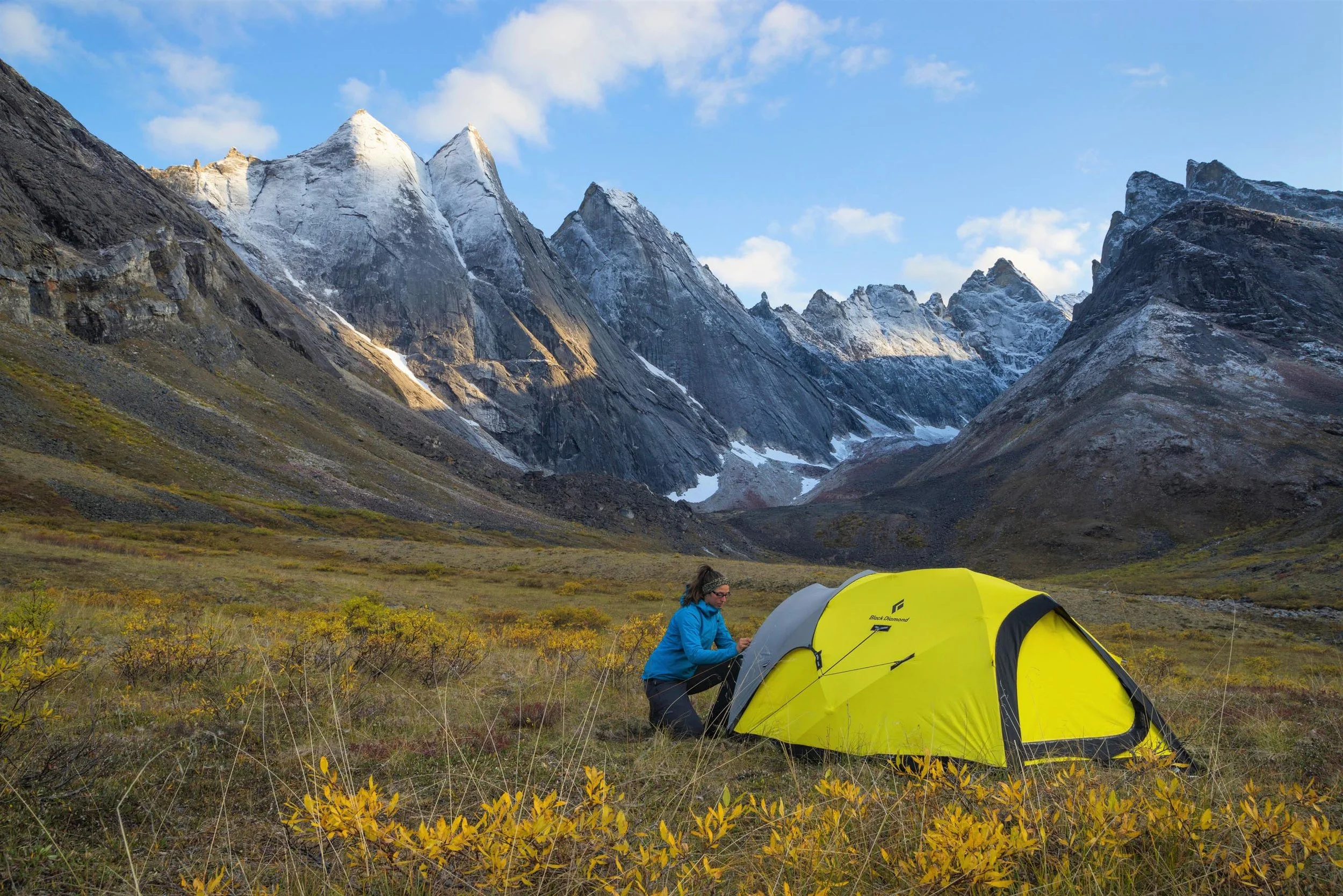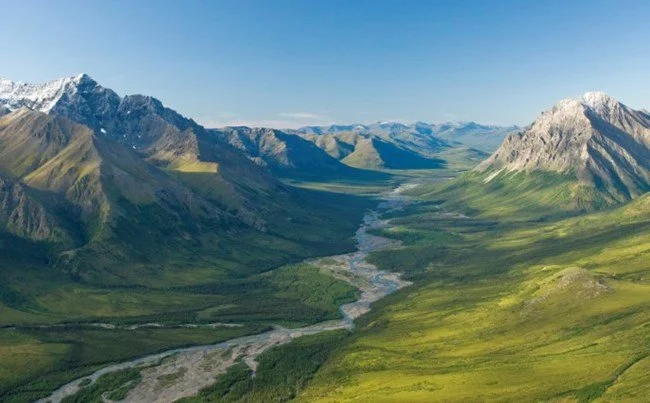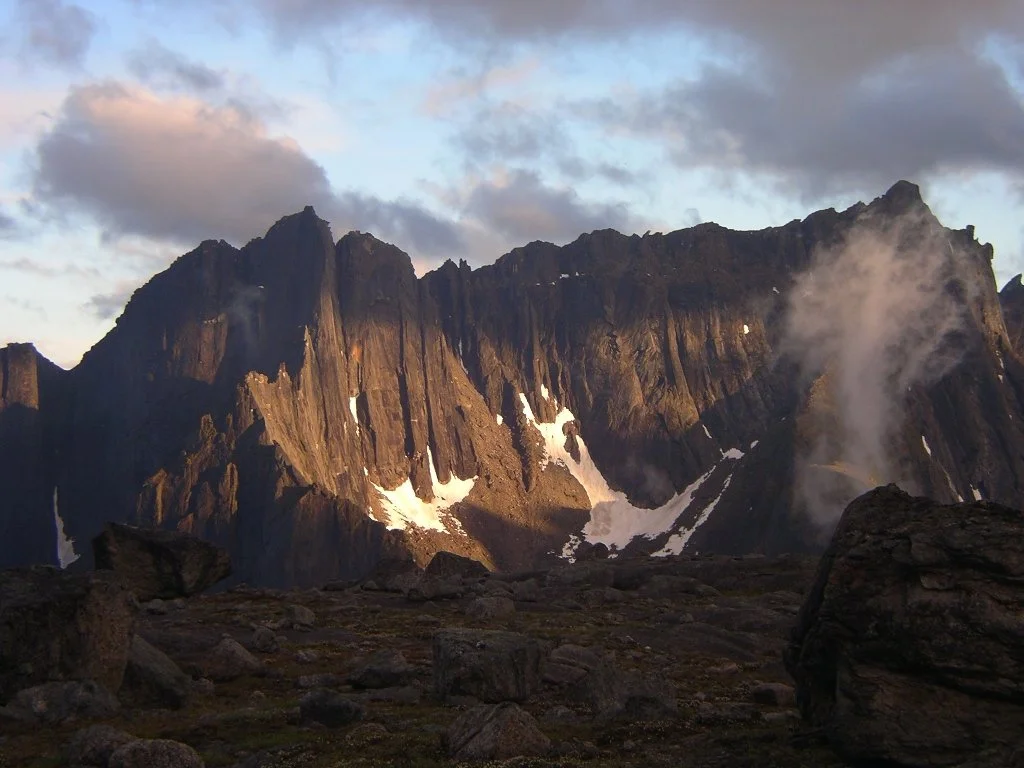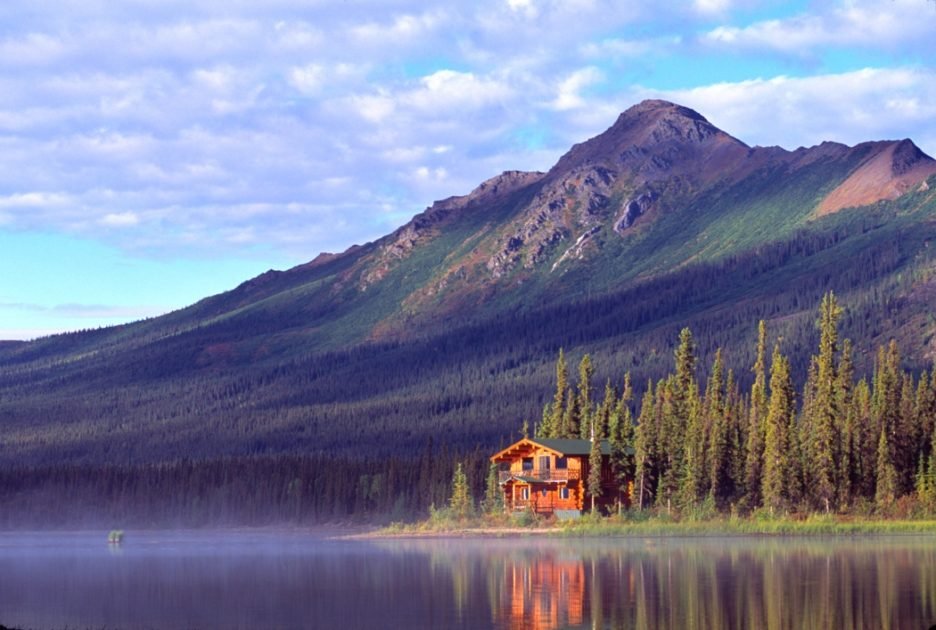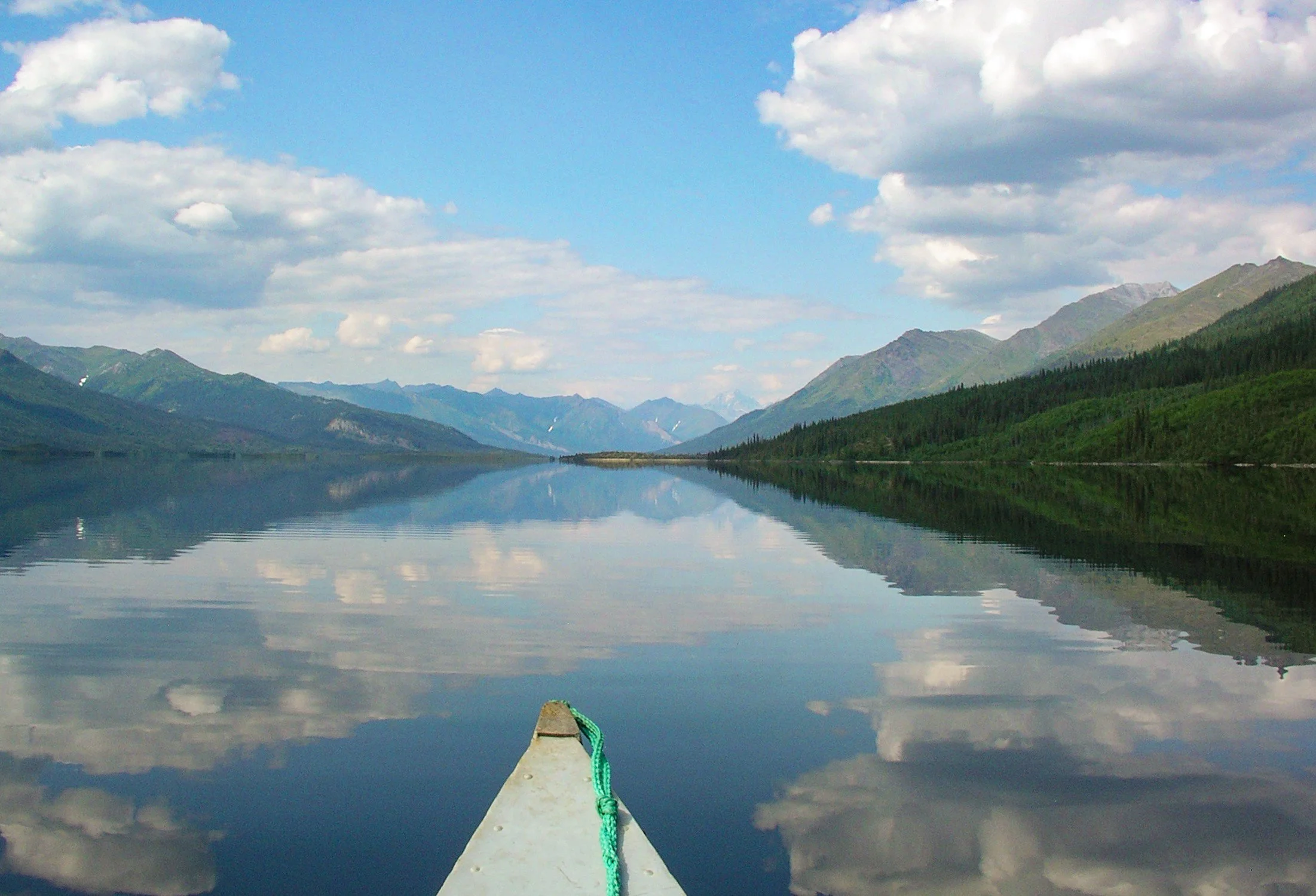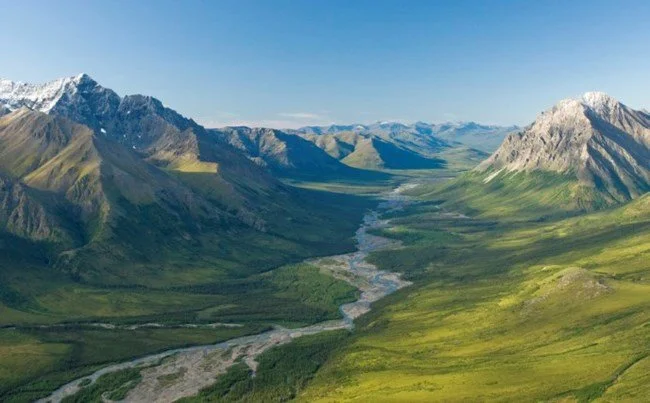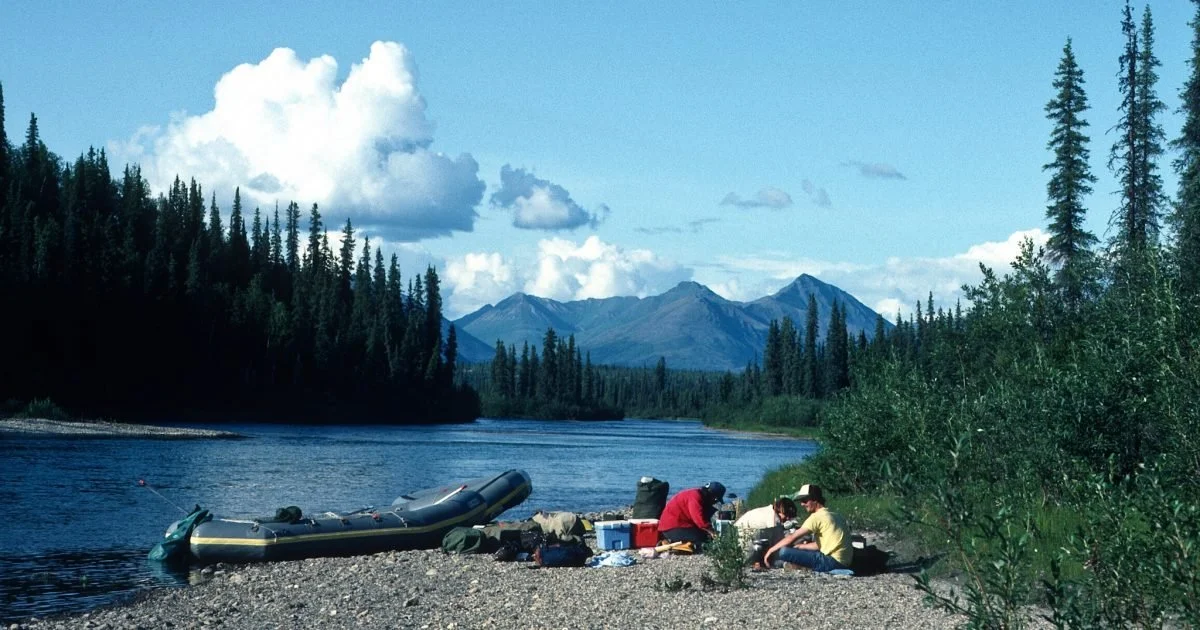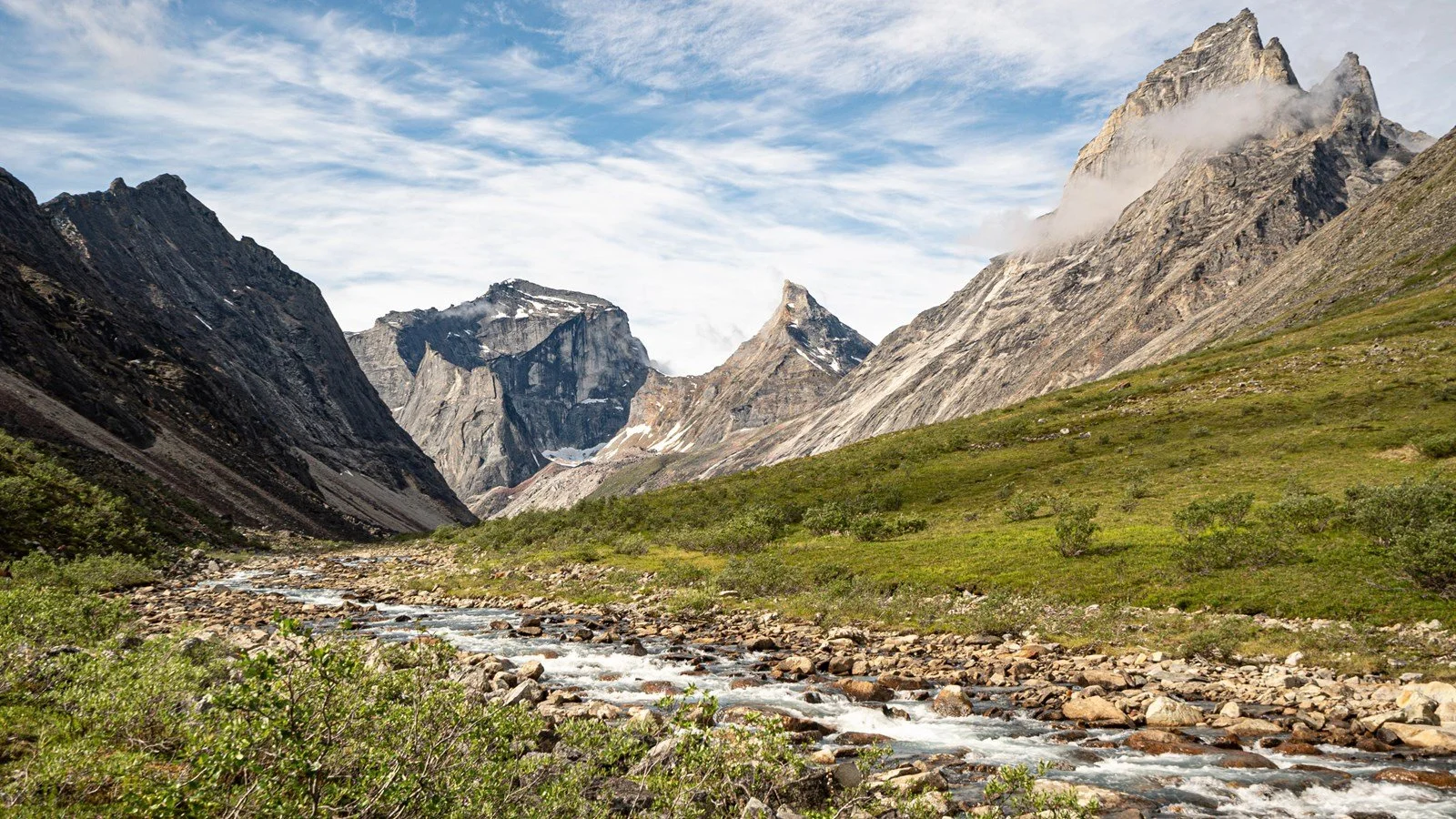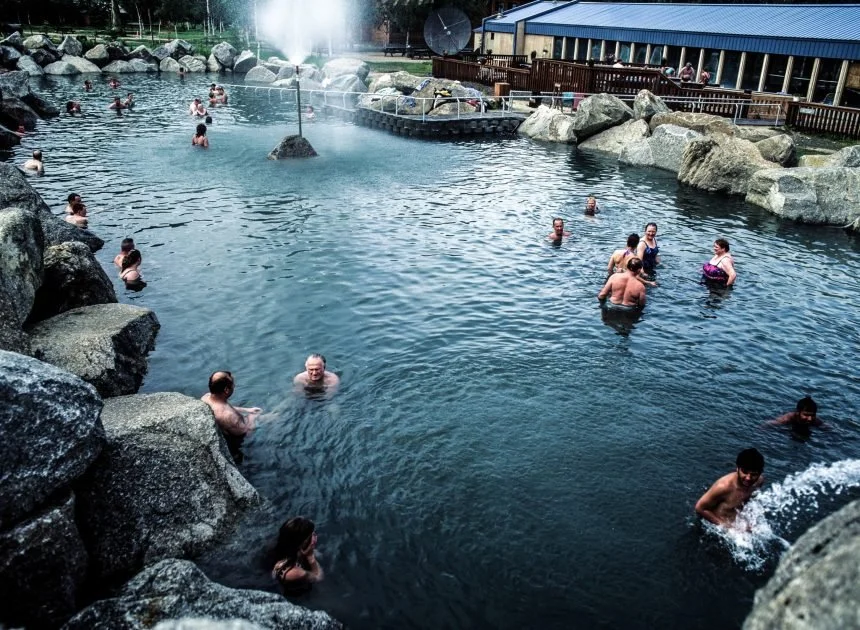How to Elope in Gates Of The Arctic National Park
Image via Travel Alaska
Welcome to Gates of the Arctic National Park! There’s so much to learn about this absolutely gigantic park, so let’s dive in! As always, let’s start out with the native history of the area:
Gates of the Arctic is the ancestral home of three main tribes: the Kuuvuan KaNianiq, the Dënéndeh, and the Inuiaq. The people who first settled on the Gwazhał (or Brooks Mountain Range) have occupied the area since 300BCE. Some remains of these early groups were discovered at Matcharak Lake, preserved by the permafrost in the area. The site leads us to see that these early settlers hunted the local animals and used finely-crafted tools for life in such a harsh environment including bone and obsidian. Although today it seems remote and desolate, a few archeological sites show us that a rich Inupiaq community was thriving in the Brooks Range foothills in the 15th century, and it helped acquire many means of survival including hunting, gathering, and seafaring that would impact and help many future generations of First Nations peoples! In the 1880s, explorers and gold miners began to explore the area, disrupting the native way of life. Many communities shifted from nomadic to permanent with the arrival of colonizers. While many communities were forced into some change, many held on to their ancestral ways of life and continue them to this day. Today, there are eleven “resident zone communities” in the vicinity of the park and the Kobuck Valley area that are allowed to practice traditional ways of living like hunting and gathering within park boundaries. The history of these people is vast and beautiful and I really encourage reading more about them!
Image via NPS.gov
AN OVERVIEW OF GATES OF THE ARCTIC
CLIMATE AND WEATHER
This park has a lot of extremes! The northern part of the park has the North Slops and the Arctic Coastal Plain, while the south side has the Yukon River and eventually gives way to the boreal forests and wetlands (boreal forests are forests that grow in “high latitude environments where freezing temps occur for 6-8 months of the year and in which trees are capable of reaching a minimum height of 5m and a canopy cover of 10%”, according to the International Boreal Forest Research Association.
The south side is a sub-arctic region with freezing winters, low precipitation, and high winds. The north is an arctic region with cooler summers, warmer winters, even less precipitation, and even more wind. There’s a big difference in elevation in the park ranging from 1000 to 8000 feet, which means there’s an equally diverse variation in weather and climate!
The spring is from March-May when the thawing of the ice begins. May starts the “break up” of river ice, so river crossing is still impossible and the temperatures can range from -10 to 50. Summer is June-September and it’s the best time to visit! Almost activities from backpacking to rafting to mountain climbing are accessible. There’s 30 days of sunlight during the summer along with lots of thunderstorms but very little snow and temps range from 40-70 degrees. The fall is very short but very vibrant, but the return of freezing temps means air taxi pilots stop service in the fall. The winter is the most brutal option, but it’s your best bet for catching the northern lights. There’s around 80” of snow in the winter, the potential for avalanches, solid rivers of ice, and temps from -70 to -33.
PEAK SEASON
The short summer is the best time to come and visit! Mid-June through September is ideal for backpacking, hiking, and the air taxis. Always remember to bring layers, as the weather can and does change rapidly without warning!
AIRPORTS, TRAVEL, & GETTING AROUND
There are no roads or trails in the park, so you’ll either have to float, hike, or fly in. The most common way to explore the park is by air taxi from three “gateway communities”: Bettles, Coldfoot, or Anaktuvuk Pass. You can hike in from the Dalton Highway or Anaktuvuk Pass, but be prepared to make a few river crossings.
Bettles is a very small (as in, a population of 2, small!) bush village with air taxi service from Fairbanks.
Anaktuvuk Pass is a Iñupiat settlement in the North Slope, and because it’s a native community, you’ll need permission from the village council to enter (you can contact them via email). There’s no road to the pass, but there’s a small history museum, community store, and a post office. You can walk through the native land, but you’ll need permission to camp.
Coldfoot is a small village 280 miles north of Fairbank you can reach by driving the Dalton Highway or get there by air taxi. They have a motel, store, cafe, and post office. You can also find campsites and trails into the park here. The nearby town of Wiseman has two lodges you can stay at as well.
Bush pilots and air taxi is by the far the best way to explore the park!
SAFETY INFORMATION
Because the park is so remote, you really are all alone during your visit. There is no cell service anywhere in the park and there are no amenities nearby. When you leave Fairbanks, Bettles, Coldfoot, or Anaktuvuk Pass, you very likely won’t see another person until you return back to one of the towns. You need to be confident you can take care of yourself out there! Make sure you know how to be self-reliant and administer first aid if needed.
Bring two copies of your detailed backcountry plan with you: one for your friends and family, and one for your pilot or starting point if you’re hiking in. This will tell people generally where to find you if you happen to not return at your scheduled time.
Be aware that weather can impact a pilot’s ability to get into the park to pick you up. If they’re unable to come get you, be prepared to spend an extra few days on your own until you can extracted.
Satellite phones (or “sat” phones) are highly encouraged! It’s the only form of communication that works in the park since there’s no cell service.
Remember to always practice Leave No Trace, but especially in a park that prides itself on minimal human impact. Follow backcountry safety guidelines, and be aware of and protect the fragile ecosystems within the park.
Bear-resistant containers are required for your overnight stay in the park and are provided free of charge at any of the visitor centers, but are first-come, first-serve. Bring your own if you can!
BEAR AND MOOSE INFORMATION
The best way to practice bear safety in the backcountry is to always assume you’re going to encounter a bear. Don’t start a trip hoping to avoid them — plan to see one and know what to do when it happens. It’s the best way to be prepared! Study bear behavior and know how to react correctly. Read about bear behavior, watch some YouTube videos, and prepare accordingly. A few starter tips: carry and know how to use bear spray, make lots of noise often (it helps scare the bear away while you’re hiking/camping), hike with others, NEVER run from a bear, stay calm if you see one, don’t try to distract them by throwing something or dropping your pack.
Moose can weigh three- to four- times more than the average bear, up to 1600lbs! Moose charge when they feel threatened. Unlike with bears, you should run as fast as you can from a moose if it begins to charge.
ENTRY FEES
Unlike many other National Parks, entry into Gates of the Arctic National Park is FREE!
Image via National Park Trust
HOW TO ELOPE IN GATES OF THE ARCTIC
HOW TO GET A WEDDING PERMIT FOR THE PARK
The permitting system here is as of June 2022 and subject to change any time. Make sure to conact the park when planning a wedding here to make sure you're doing so legally! You only need a permit for your elopement if there will be more than 12 people or you're setting up a structure (like an arch). Apply no less than 14 days before, and be ready to pay $100 for the permit.
HOW TO GET A MARRIAGE LICENSE IN ALASKA
Both parties must be at least 18 years old. There is a three-day waiting period that begins once a mailed or faxed application payment is received by the issuing office. If you need it quickly and cannot pick it up in person, you can have it shipped with Priority Mail. The license is valid for three month from the date of issuing. If you have been divorced before, you need to state the beginning and ending dates of your previous marriage on the application.
VALID OFFICIANTS IN ALASKA
A minister, priest, recognized leader, or rabbi of any church or congregation in the state, a commissioned officer of the salvation army, marriage commissioner, or a judicial officer of the state, as well a friend or relative to perform your ceremony (if they get a marriage commissioner appointment from an Alaskan court as authorized by AS25.05.081.2)
VENDORS FOR GATES OF THE ARCTIC
Remember that Gates of the Arctic is extremely remote, and most vendors don’t cater to the park itself. If you’re traveling from Fairbanks, you have more options for florists, HMUA, and other vendors but in general I recommend getting confident with doing your own hair and makeup in the backcountry! Because of the lack of options near the park, I’m only going to link some florists along with some tour guides who are perfect for helping you traverse the backcountry by kayak, hike, or air!
BEST CEREMONY LOCATIONS IN GATES OF THE ARCTIC
Iniakuk Lake Wilderness Lodge
The only way to access the lodge is by flying in and it’s worth it! It sits 60 miles north of the Arctic Circle and offers private cabins, solar power, local dishes prepared on-site, down comforters, and all the amenities you might be missing in the wildness of the far north.
Mount doonerak
Situated in the Endicott Mountains in the greater Brooks Range, this mountain is possibly as remote as you could possibly get. Hire a bush pilot to take you up to one of the surrounding peaks for a truly epic backdrop for your vows!
Walker Lake
Sitting on the south side of the Brooks Range, this mountain lake is unique for it’s limited forestation because of being in the subarctic climate. It’s beautiful, glassy color is perfect for a sunrise elopement!
Go exploring in the wild backcountry!
This park is the one for you if you truly want to be off the grid! There are no roads and no trails here, so the whole park is open for you to explore! My best advice is to hire a guide to take you down the rivers, up the mountains, and across the wild arctic plains. Local guides will show you all the park has to offer!
Kobuck River
There’s 380 miles of river to explore! Start at Walker Lake and work your way down through sandstone boulders, low mountains, high bluffs, and unobstructed views of the region. There’s lots of rafting opportunities as well as fishing and kayaking! Plus, the caribou herds can often be found here watering, so wildlife viewing is sure to be absolutely incredible.
arrigetch peaks
These mountains have been a landmark to the Nunamiut people for millennia. Carved out by ancient glaciers, these granite spires give way to deep valleys, modern alpine glaciers, boreal forests, and running rivers. Besides being located in a national park, the Arrigetch Peaks are a National Natural Landmark, too! This is my personal favorite option for an elopement location. Truly iconic.
WHAT TO PACK FOR GATES OF THE ARCTIC
GENERAL PACKING
Because Gates of the Arctic comes with its own set of unique challenges with being almost entirely in the backcountry, there are some pretty important things to pack!
Sturdy hiking boots and at least a few pairs of wool or synthetic socks to keep your feet warm. Also consider bringing gaiters for river crossings!
A backpack that is fitted correctly and can carry your personal gear, a tent, and a rain fly for your pack.
A rain jacket and pants, NOT a rain poncho.
Warm, quick-drying clothing is very important! Cotton won’t keep you warm if you get wet, so stick to wool or synthetics like polypropylene or nylon. Bring quick-drying pants, at least one long-sleeved shirt, long underwear, a winter hat, waterproof gloves, and a fleece jacket. If you’re coming in the winter, know how to dress for sub-zero temperatures.
A stove, fuel, cookware, water bottles, and water purifying tablets or a water filter.
A sleeping bag and a pad.
Emergency gear and The Ten Essentials.
Bear Spray
Always bring a map! While apps like AllTrails are great, your phone could die or you could drop it in a puddle and poof — there go your maps. Paper maps are still a thing, I promise.
Be prepared with the bug trifecta: the right clothes, bug repellant, and something to treat bug bites. If you can stand it in the summer, pants will help shield you from ticks, black flies, and mosquitos. The same goes for long-sleeved shirts (you can even find some with SPF!).
Remember that sunburns can happen even on cloudy days, and especially on snowy (but sunny) days. Protect that beautiful skin of yours.
PACKING FOR YOUR ELOPEMENT
You wouldn’t forget your dress or your suit (hopefully), but what about all the other little things? Here’s a short list of extras you might be forgetting:
A way to transport your ceremony clothing (whether by wearing it on a hike, packing it in a backpack, or just using garment bags)
Your rings! (A pretty important part, tbh.)
Vow books, clothing accessories (ties, cufflinks, belts, safety pins, stain remover), jewelry, perfume and deodorant, letters to each other, small trinkets, and anything else you plan on including during your elopement.
All of your legal documents, including park entrance passes, park wedding permits, IDs, and your marriage license (you’ll also need your passports if you’re coming from out of the country).
HOW TO ENJOY GATES OF THE ARCTIC
WHERE TO STAY
Your best bet for where to stay is either in the backcountry, at Iniakuk Lake Wilderness, Lodge, or one of the options in Fairbanks! Since I talked about Iniakuk earlier in this post, let’s dive into some of the other options in town!
Pike’s Waterfront Lodge
Everything you could hope for and more is here at Pike’s! Rooms starting at the basic and simple move up to private log cabins with fireplaces, wheelchair accessible rooms to celebrity suites. There’s also a great restaurant that offers Sunday brunch along with a breakfast and dinner buffet. Besides the rooms here, the lodge also offers a cozy theatre, a 1000-book library featuring all-Alaskan literature spanning native culture to history and the gold rush to exciting fiction, a short cue billiards speakeasy, an aromatherapy steam room and dry sauna, and a museum-quality art collection featuring Alaskan art.
Chena Hot springs resort
For being a resort, this spot is still true to the “wild” Alaskan feel you’re after. It’s about an hour outside Fairbanks but well worth the trip! Besides soaking in the natural hot springs, you can enjoy the ice bar (in a building made of actual ice!), dog sledding, snow mobile tours, horseback riding, floating the river, trying your hand at ice fishing, and so much more. You can stay in the traditional lodge, a wide range of cabins, primitive yurts, or bring your tent or RV to stay on the property in your own housing.
Borealis Basecamp
Just outside Fairbanks sits Borealis Basecamp! You can spend the night in your very own “igloo” that’s perfect for watching the northern lights through a clear ceiling from your bed. For touting the idea of being off-the-grid, the igloos give you every amenity you could want: showers, sinks, toilets, soaps, shampoos, hairdryers, and even a beverage bar ready with hot coffee, cocoa, and tea. If the igloo isn’t quite what you had in mind, head to one of the “Cube" hideaways that have panoramic, 10-foot windows to give a view of the forest and night skies from the king bed all the way to the deck outside. There’s a restaurant here that focuses on traditional Alaskan food and includes all sustainable seafood and local produce.
WHAT ELSE TO DO
While the park doesn’t boast a lot of traditional “activities”, there’s no shortage of outdoor adventure here! Get out there and adventure!
Float the rivers! There are many rivers running through the park, and six of them are designated Wild Rivers. For a river to get this designation means that it has the strongest level of protect the government can give it. It must have “remarkable scenic, recreational, geologic, fish and wildlife, historic, or other similar values”, according to the USDA. The six Wild Rivers here are the John River, Noatak River, Kobuck River, Alatna River, Tinyaguk River, and the North Fork of the Koyukuk River. You can also float the Killik, Itkillik, and the Nigu.
Hire an air taxi to take you on an arial trip of the park! This option is great for those that don’t have (or don’t want to use) backcountry camping and survival knowledge but still want to experience all the park has to offer. You can find a list of Air Taxi guides recommended by the NPS right here.
Get your NPS Passport Book stamped! You can get your stamps at the Bettles Visitor Center and the Arctic Interagency Visitor Center in Coldfoot.
A LIST OF RECOMMENDED GUIDES
Please click through these links for recommended guides and services vetted by the National Park Service. As always, do your own research as well to make sure you feel comfortable with your pilot and guides!
A complete list of guides and services provided by the National Park Service
“Gates of the Arctic is one of the last truly wild places on earth. Here you can take a journey of adventure, discovery and solitude through vast valleys and gaunt mountains of rugged beauty, and experience intact ecosystems where people have lived with the land for thousands of years.”
READY TO BOOK YOUR DREAM ELOPEMENT IN GATES OF THE ARCTIC?!
All photographs courtesy of Traveling Geologist, The National Park Service, and Alaska.org.
